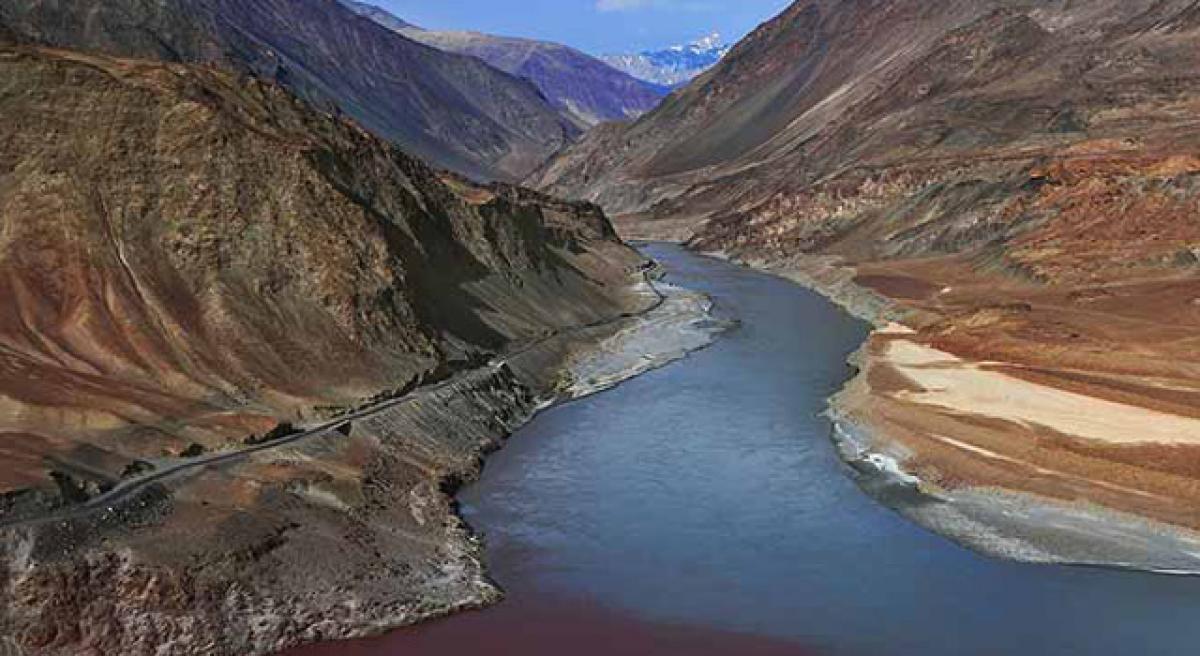Live
- Adding zing to electioneering
- Hyderabad Comic Con 2024 Concludes
- Maha battle fluid: All keep their fingers crossed
- Five PHC staff placed under suspension
- New TTD Trust Board to meet in Tirumala today
- Drone survey held for laying smart roads
- MyVoice: Views of our readers 18th November 2024
- It’s time to defeat betrayers: Revanth in Maharashtra
- Committees formed, assigned tasks
- Let law and order be in sole domain of union!
Just In

The five dams forming the North Indus River Cascade that China has just promised to finance and build in Pakistan including Pakistan-administered Kashmir has the potential to generate over 22,000 MW in an energy-starved country.
The five dams forming the North Indus River Cascade that China has just promised to finance and build in Pakistan including Pakistan-administered Kashmir has the potential to generate over 22,000 MW in an energy-starved country. But the dams will also stop the flow of silt which is the lifeline of agriculture downstream. In non-monsoon months from October to June, they may also reduce the flow of water down the Indus to Pakistan's Punjab and Sindh provinces.
Climate change is making water flow along rivers more erratic. Pakistan's entire water supply for agriculture, factories and homes is dependent on rivers in the Indus basin. Water availability is already below the 1,000 cubic metres per person per year level at which a country is described as water-scarce, according to the global norm followed by most UN agencies.In this situation, it is critical to look at the food, energy and water together, as a nexus. Instead, the planners of Pakistan appear to be looking at energy alone.
China is providing Pakistan with $50 billion for the Indus Cascade. An MoU was signed to this effect during the recent Belt and Road Initiative (BRI) conference in Beijing. China's National Energy Administration (NEA) will oversee the funding. China Three Gorges Corporation which runs the world's largest hydroelectricity project at the Three Gorges Dam is the frontrunner to build the five dams that will form the cascade.
This is in addition to the $57 billion China is providing to Pakistan for a series of infrastructure projects along the China-Pakistan Economic Corridor (CPEC), a part of BRI. The infrastructure projects include the building of coal-fired power stations and the port at Gwadar on the Arabian Sea, at the end of the corridor.
The cascade is planned all the way down the Indus from Gilgit-Baltistan to the existing Tarbela dam near Islamabad. It will effectively turn this huge transboundary river into a series of lakes in the last part of its journey through the Hindu Kush Himalayas to the plains of South Asia. The uppermost of the five dams is being planned at Bunji near Skardu in Pakistan-held Kashmir.
The 7,100 MW Bunji Hydropower Project has been described by Pakistan's Water and Power Development Authority (WAPDA) as a run-of-the-river (RoR) project. But the promotional video (for the entire cascade) which provides this description also says it will have a reservoir that will be spread along a 22-km stretch of the Indus and inundate a 12-km stretch of the road between Gilgit and Skardu the two main towns of Gilgit-Baltistan. So, despite the description, this may not be an RoR project.
The next dam in the cascade is the big one Diamer-Basha with a planned live storage of 6.4 million acre feet (MAF) of water and a hydropower generating potential of 4,500 MW. The Diamer-Basha dam is being promoted by WAPDA as a sediment trap and therefore good for downstream hydropower projects. But the same sediment mainly silt rejuvenates the soil downstream every year and has been the main reason why agriculture has been sustained in the Indus valley for millennia.
Building the Diamer-Basha dam is estimated to cost $15 billion. Now China has promised funding. Just downstream of Diamer-Basha is the third dam in the cascade the 4,320 MW Dasu Hydropower Project. This will have a reservoir that will stretch upstream for 74 km along the Indus, all the way to the Diamer-Basha dam, according to WAPDA. It will also submerge 52 km of the Karakoram Highway.
Some of the peripheral work for this project has started, and people have already been displaced, with WAPDA seeking contracts for resettlement and providing free transport to resettlement sites. And immediately downstream of that, WAPDA has planned the 2,200 MW Patan Hydropower Project, with a 35-km-long reservoir that goes up to the Dasu dam.
Once again, the fifth dam in the cascade is just a little downstream the 4,000 MW Thakot Hydropower Project in which the plan is to divert the Indus waters through four headrace tunnels to generate electricity. At the MoU signing ceremony, Prime Minister Nawaz Sharif spoke glowingly of cooperation between the two governments to overcome Pakistan's energy crisis and added: "Water and food security are of paramount importance for Pakistan keeping in view the challenges posed by climate change."
However, the Indus Cascade will actually reduce water and food security in Pakistan. One proven effect of climate change is an intensification of the water cycle. In lay terms, it means fewer rainy or snowy days but more intense rainfall or snowfall in those days. Pakistan is already suffering the effects. For the first nine years in this century, the Indus failed to reach the sea.
Then there was such a cloudburst in 2010 that a fifth of the country was flooded. The floods also brought down, and continue to bring down, huge sediment loads that reduce the working lives of dams. To build more large dams in this situation appears dangerously short-sighted. (In arrangement with thethirdpole.net)
By Joydeep Gupta

© 2024 Hyderabad Media House Limited/The Hans India. All rights reserved. Powered by hocalwire.com







